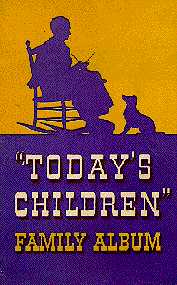|
The 'Soaps' in Chicago...
"Today's
Children"
And
the 1935 "Today's Children" Family Album
| "What
the future will bring into their lives, no one knows. How will Ellen settle the
age-old problem of career versus marriage? Will Fran marry Henry Matthews or will
her renewed interest in Ralph Martin lead to further complications? Will Bob make
a success in politics is he merely headed for more trouble, and just what Kay
think of the whole business? Listen---and find out..." |
| Curator's
note:
The above quotation comes from the "Today's Children" Family
Album, offered to listeners as a premium in 1935 by the Pillsbury Flour Mills
Company, the sponsor of one of network broadcasting's earliest soap operas. The
album---with original text and illustrations---is presented here as a hypertext
document. No proof-of-purchase or postage fees are required. |
 |
Background
Today's Children
was the first network soap of Irna Phillips. The show evolved from Painted
Dreams, a continuing dramatic sketch Ms. Phillips devised in 1932 that was
integrated into a mid-day WGN variety show. Painted Dreams centered on
the often problematical lives of the members of the Malone family, headed by the
folksy and very wise Mother Malone.
A year later, when
WGN resisted her efforts to make Painted Dreams free-standing and to offer
it to a network, Ms. Phillips took the show to WMAQ. She changed the name of the
show and the surname of the family around which the plot revolved. Mother Malone
thus became Mother Moran. Within a few months Today's Children acquired
Pillsbury sponsorship and a secure network slot.
Ms. Phillips
and WGN engaged in a lengthy legal battle over who had ownership rights to Painted
Dreams. She eventually lost on appeal. But by that time the success of Today's
Children---and the other soaps that she devised and wrote in its wake---more
than compensated for her defeat in court. (In addition to writing the show, Ms.
Phillips played the role of Mother Moran and doubled as Katherine Crane.)
Today's Children
was a major contributor to the revolution in daytime network broadcasting that
shifted emphasis from music and variety programs (which were expensive to produce
and difficult to sponsor) to continuing dramatic episodes (which were cheap by
comparison and easy to sell). By the time Pillsbury offered the "Today's
Children" Family Album, the soaps had become so much in demand that NBC
was obliged to add three studios to its Merchandise Mart complex simply to handle
the production pressure.
By the mid-1930's,
commercial broadcasters had realized that women in the age range of 18 to 45 were
their most significant audience---and that the soaps were the most effective way
of reaching them. |
|
Learn
more about your favorite "Today's Children" characters:
Additional Today's Children links:
Comments
or suggestions? click
here to send them to Rich Samuels
Created by
Rich Samuels (e-mail to rich@richsamuels.com)
|
















